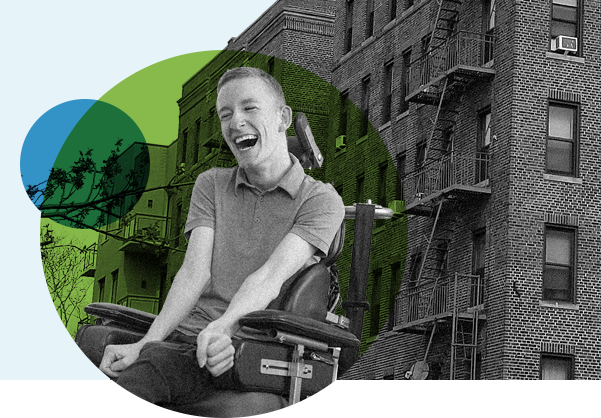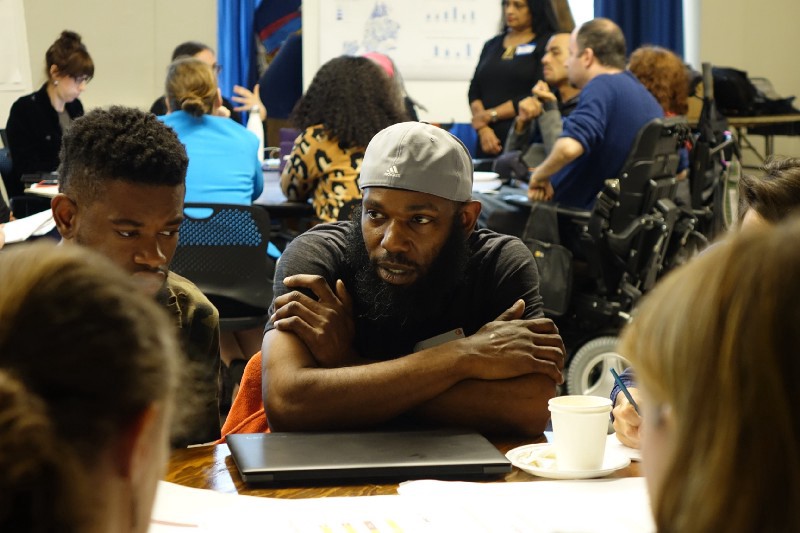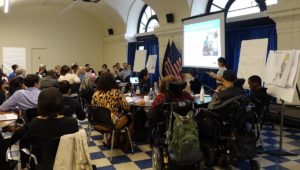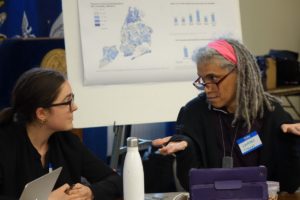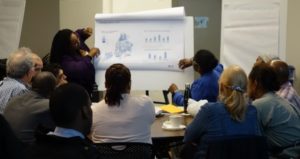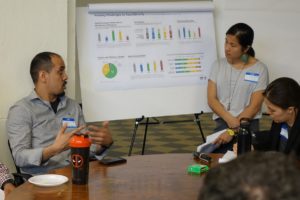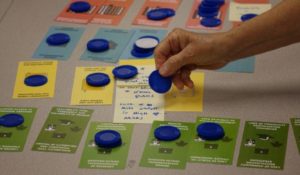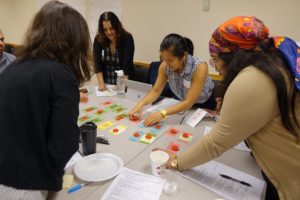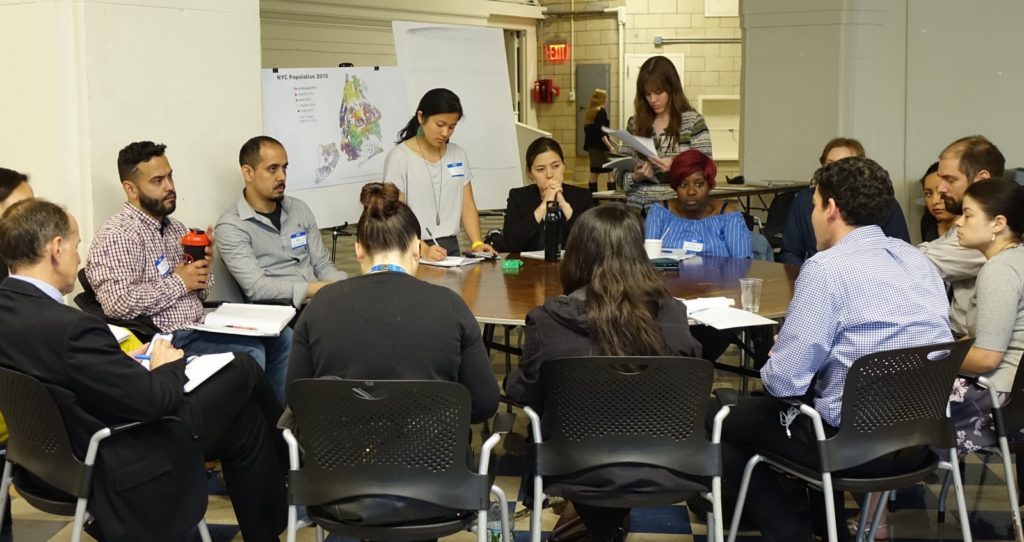Learning from the City’s Fair Housing Stakeholder Group
Launched earlier this year, Where We Live NYC is the City of New York’s collaborative process to promote fair housing, confront segregation, and take action to advance opportunity for all. As part of our extensive public engagement strategy , the City has created the Fair Housing Stakeholder Group of more than 150 advocates, service providers, housing developers, researchers, and community leaders. Through facilitated small group discussions, these stakeholders are sharing insights into how fair housing challenges like segregation and discrimination impact New Yorkers’ lives, as well as providing input into what actionable strategies can move us towards a more just and inclusive city. To facilitate an iterative and transparent process, this blog post provides an update on what we have learned from the Fair Housing Stakeholder Group to date.
HOW IT WORKS
Feedback from the Fair Housing Stakeholder Group is one of many key inputs into the Where We Live NYC process. The perspective of stakeholders — along with extensive data analysis and resident engagement — is helping to shape the next chapter of fair housing policy in New York City. We are convening the Fair Housing Stakeholder at three critical phases throughout the Where We Live NYC process:
- Learn Phase (Spring/Summer 2018): Discuss existing conditions, inform data analysis, and prioritize the factors that contribute to fair housing challenges in New York City.
- Create Phase (Fall 2018): Surface ideas for policy solutions based on the information and contributing factors prioritized in the Learn Phase.
- Finalize Phase (2019): Share feedback on an initial policy framework, with the final draft scheduled for completion in fall 2019.
For the Learn Phase, stakeholders were invited to participate in discussions on different fair housing issues that they could self-select. One discussion focused on residential living patters and the Cause of Segregation & Integration; another on Disproportionate Housing Needs faced by different populations in New York City; and four discussions explored how where we live impacts our access to quality Education, Employment & Economic Opportunity, Safe & Healthy Environments, and Transportation.
The discussions were lead by the NYC Department of Housing Preservation & Development (HPD), and we worked closely with range of government partners — including the NYC Housing Authority, Department of City Planning, Department of Health & Mental Hygiene, Department of Transportation, City Commission on Human Rights, Mayor’s Office of People with Disabilities, and many others.
DESIGNING THE DISCUSSION
To support productive and inclusive discussions, HPD worked to ensure there was a diversity of voices in each room, and that participants agreed on a set of rules to have candid but respectful exchanges. From there, we focused the discussion on two key questions:
What do fair housing challenges in New York City look like today?
Each discussion started with HPD and partner agencies framing the fair housing topic, sharing relevant history and context, and providing preliminary data. Much of this grounding information was modeled after the U.S. Department of Housing & Urban Development (HUD) Affirmatively Furthering Fair Housing (AFFH) Rule, Guidebook, and Data and Mapping Tool. The City is continuing to use the AFFH framework, despite recent setbacks from the federal government.
To start each meeting, we shared a set of initial data, most of which was provided by HUD. But we wanted to understand how our analysis could better capture the nuance of local fair housing challenges, so we asked participants to tell us what other information or research might be needed to better assess the unique conditions and needs in New York City. Many provided suggestions for future analysis, cited existing studies, and shared qualitative information about the diverse populations they serve and represent.
“The roundtable was incredibly helpful in learning what housing-related challenges other organizations serving immigrants and people of color are facing.” — Stakeholder at the Roundtable on Disproportionate Housing Needs
Stakeholders respond to initial data and help the City expand our analysis and understanding of existing conditions for fair housing issues in New York City.
What are the root causes of fair housing challenges?
During the second half of each meeting, we asked stakeholders to identify the root causes behind present day challenges and inequities. To help facilitate the discussion, HPD created an interactive voting exercise that allowed each stakeholder to rank the root causes or “contributing factors” to fair housing issues that HUD provided in the AFFH Guidebook. Stakeholders also had the option to add their own. Once these factors were ranked, we engaged in a lengthy discussion about why certain factors were prioritized and how they contribute to fair housing challenges based on the experiences of participants or the populations that they represent. The discussions were challenging but rewarding, and will be used to inform our approach to develop fair housing goals and strategies moving forward.
“We were consistently encouraged to look at the root causes, and the flow of the conversation was productive and smooth.” — Stakeholder at the Roundtable on Environment, Health, & Safety
Stakeholders participate in an interactive exercise to prioritized root causes to different fair housing issues.
WHAT WE’RE LEARNING
The thoughtful participation of stakeholders in the Learn Phase has been critical to informing the City’s understanding of the existing conditions and root causes to issues like segregation, disparate housing challenges, and unequal access to opportunity. Here is a selection of key insights:
- Causes of Segregation & Integration: Participants identified gentrification, displacement, and loss of affordable housing as critical aspects of understanding the existing conditions of segregation and integration in New York City. Participants also stressed that an analysis of these issues should include social integration as well as barriers to accessing White concentrated areas of wealth.
- Disproportionate Housing Needs: Participants identified unique challenges faced by certain populations in accessing both private and publicly-supported housing. These include physical accessibility issues, administrative language barriers, informal incomes or credit score barriers, lack of documentation, or discrimination and social stigma against their characteristics. While there are unique challenges for each population group, participants identified affordability as an issue affecting all protected class populations.
- Education: Participants expressed that the combination of school zoning and choice policies are major drivers of segregation and disparities in educational opportunities. Participants noted that low-income families, immigrants, and homeless families do not always have the knowledge or ability to exercise choice due to language barriers, limited time and resources, and physical distance. Participants also noted that White affluent families move into high performing school zones and price out low-income families, or exercise choice to send their kids out of low-performing school zones.
- Environment, Health, & Safety: Participants stressed the connection between unstable housing, economic insecurity, and poor individual and neighborhood health. Participants explained that there are severe mental, physical, and emotional health impacts of living in poverty that can be exacerbated by neighborhood change and gentrification, which can increase housing instability and stress, and fray social networks that protect against negative health outcomes.
- Employment & Economic Opportunity: Participants emphasized the role of community networks in determining economic opportunity. Participants noted that segregation and the concentration of wealth and poverty impact an individual’s ability to access specific career paths, high-paying jobs, and supportive institutions.
- Transportation: Participants stressed the interconnectivity between housing, transit access, and land value that reinforces differences in access to transit opportunities. Participants noted that high-income earners often have the shortest commutes and lower transportation costs, while low-income earners have the longest commute times and higher costs. Because of land cost dynamics, affordable housing is often built in areas with limited transit options.
You can access the full synthesis notes from each of the six topics below:
- Causes of Integration & Segregation: Learn Phase Notes (May 4, 2018)
- Disproportionate Housing Needs: Learn Phase Notes (May 22, 2018)
- Education: Learn Phase Notes (June 5, 2018)
- Environment, Health, & Safety: Learn Phase Notes (June 22, 2018)
- Employment & Economic Opportunity: Learn Phase Notes (July 12, 2018)
- Transportation: Learn Phase Notes (July 25, 2018)
NEXT STEPS
In the upcoming set of Create Phase discussions, the City will invite stakeholders to provide feedback on the synthesis notes from the Learn Phase and share policy suggestions to address the root causes to fair housing issues. These suggestions can include new interventions, as well as insights into gaps in existing programs and policies at the city, state, and federal levels. Over the coming months, we will keep providing updates on our engagement with the Fair Housing Stakeholder Group and with residents as the Where We Live NYC process continues.
If your organization is interested in joining the Fair Housing Stakeholder Group, please email wherewelivenyc@hpd.nyc.gov.
Find more information on Where We Live NYC at nyc.gov/WhereWeLive.
